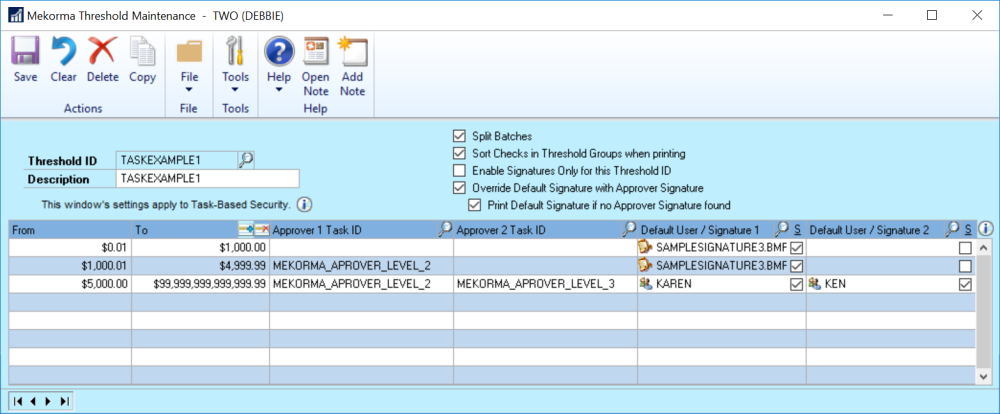Processing Split Batches Using Task-Based Security with Approvals
Split batches are enabled on a per checkbook basis by assigning a Threshold ID to that checkbook. When a batch goes through the approval workflow and approvals are requested, the batches will be split based on the Threshold ID logic applied to the checkbook.
When the batches are split, the naming convention changes and the original batch name is appended to include “_01,” “_02”, and so forth, depending on configured threshold logic included within the Threshold ID.
Threshold IDs can be applied to a Vendor Class and they can be applied to a Checkbook. If you have Vendor Class security configured, here is how those Vendor Class and Checkbook security configurations interact:
- A Vendor Class is assigned a Threshold ID with split batches enabled: Any payments associated with this Vendor class will be split from the original batch regardless of whether the Checkbook’s Threshold ID has Split Batch enabled.
- A Vendor Class is assigned a Threshold ID that does not have Split Batches enabled: Payments associated with that vendor class will default to the rules applied to the Checkbook’s Threshold ID.
Example of Split Batch Feature in Action
In the example below, the Threshold ID named “TASKEXAMPLE1” is configured with 3 different threshold levels:

When a batch is created and processed with this Threshold ID logic applied, the batches are split in this way:

- Transactions in the first Threshold Level (from $0.01 to $1,000.00) remain in the first batch with the name “APBATCH” staying the same.
- Transactions in the second Threshold Level (from $1,000.01 to $4,999.99) are split into the next batch named “APBATCH_01.”
- Transactions in the third Threshold Level (from $5,000.00 to $999, 999, 999, 999, 999.99) are split into the next batch named “APBATCH_02.”
This pattern continues depending on the number of threshold levels you have in your Threshold ID logic.
Processing Split Batches Using Legacy Security By User ID
If the split batch feature is enabled, batches are split during the workflow process based on the following logic: If the When to Require Passwords field is set to:
- Always One: all transactions are transferred to the A1 batch which requires one approver and the original batch is removed. The A1 batch is submitted into the workflow for approval.
- Always Two: all transactions are transferred to the A2 batch which requires two approvers and the original batch is removed. The A2 batch is submitted into the workflow for approval.
- One Password if Over Threshold; None if Under: all transactions with amounts over the threshold are transferred to the A1 batch which requires one approver and the original batch is available for printing without approval. The A1 batch is submitted into the workflow for approval.
- Two Passwords if Over Threshold; One if Under: the batch is split into A1 and A2 and all transactions with amounts over the threshold are transferred to the A2 batch which requires two approvers and remaining transactions are transferred to A1 which requires one approvers. Both batches are submitted into the workflow for approval and the original batch is deleted.
When the batches are split, the naming convention changes and the original batch name is appended to include either an “A1” or an “A2”, depending on the number of approvers required. So for example, a batch named “AP JUNE” becomes either “AP JUNE-A1” or “AP JUNE-A2”. The batch name is limited to 12 characters or less.
Need more help with this?
We value your input. Let us know which features you want to see in our products.

